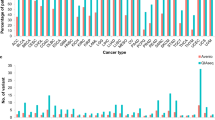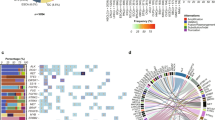Abstract
Tumor DNA sequencing is becoming standard-of-care for patient treatment decisions. We evaluated genotype concordance between tumor DNA and genomic DNA from blood and catalogued functional effects of somatic mutations in 21 drug response genes in 752 solid tumor patients. Using a threshold of 10% difference between tumor and blood DNA variant allele fraction (VAF), concordance for heterogenous genotype calls was 78% and increased to 97.5% using a 30% VAF threshold. Somatic mutations were observed in all 21 drug response genes, and 44% of patients had at least one somatic mutation in these genes. In tumor DNA, eight patients had a frameshift mutation in CYP2C8, which metabolizes taxanes. Overall, somatic copy number losses were more frequent than gains, including for CYP2C19 and CYP2D6 which had the most frequent copy number losses. However, copy number gains in TPMT were more than four times as common as losses. Seven % of patients had copy number gains in ABCB1, a multidrug resistance transporter of anti-cancer agents. These results demonstrate tumor-only DNA sequencing might not be reliable to call germline genotypes of drug response variants.
This is a preview of subscription content, access via your institution
Access options
Subscribe to this journal
Receive 6 print issues and online access
$259.00 per year
only $43.17 per issue
Buy this article
- Purchase on Springer Link
- Instant access to full article PDF
Prices may be subject to local taxes which are calculated during checkout



Similar content being viewed by others
Data availability
Sequencing data is available in dbGaP (accession number: phs001713.v1.p.1).
Code availability
Available upon request.
References
Gillis NK, Patel JN, Innocenti F. Clinical implementation of germ line cancer pharmacogenetic variants during the next-generation sequencing era. Clin Pharm Ther. 2014;95:269–80.
Jones S, Anagnostou V, Lytle K, Parpart-Li S, Nesselbush M, Riley DR, et al. Personalized genomic analyses for cancer mutation discovery and interpretation. Sci Transl Med. 2015;7:283ra53.
Raymond VM, Gray SW, Roychowdhury S, Joffe S, Chinnaiyan AM, Parsons DW, et al. Germline findings in tumor-only sequencing: points to consider for clinicians and laboratories. J Natl Cancer Inst. 2016;108:djv351.
Cummings J, Ethell BT, Jardine L, Burchell B. Glucuronidation of SN-38 and NU/ICRF 505 in human colon cancer and adjacent normal colon. Anticancer Res. 2006;26:2189–96.
DeLoia JA, Zamboni WC, Jones JM, Strychor S, Kelley JL, Gallion HH. Expression and activity of taxane-metobolizing enzymes in ovarian tumors. Gynecol Oncol. 2008;108:355–60.
Fujitaka K, Oguri T, Isobe T, Fujiwara Y, Kohno N. Induction of cytochrome P450 3A4 by docetaxel in peripheral mononuclear cells and its expression in lung cancer. Cancer Chemother Pharm. 2001;48:42–6.
Fukui Y, Oka T, Nagayama S, Danenberg PV, Danenberg KD, Fukushima M. Thymidylate synthase, dihydropyrimidine dehydrogenase, orotate phosphoribosyltransferase mRNA and protein expression levels in solid tumors in large scale population analysis. Int J Mol Med. 2008;22:709–16.
Fukushima M, Morita M, Ikeda K, Nagayama S. Population study of expression of thymidylate synthase and dihydropyrimidine dehydrogenase in patients with solid tumors. Int J Mol Med. 2003;12:839–44.
Knüpfer H, Schmidt R, Stanitz D, Brauckhoff M, Schönfelder M, Preiss R. CYP2C and IL-6 expression in breast cancer. Breast. 2004;13:28–34.
Martínez C, García-Martín E, Pizarro RM, García-Gamito FJ, Agúndez JAG. Expression of paclitaxel-inactivating CYP3A activity in human colorectal cancer: implications for drug therapy. Br J Cancer. 2002;87:681–6.
Miyoshi Y, Ando A, Takamura Y, Taguchi T, Tamaki Y, Noguchi S. Prediction of response to docetaxel by CYP3A4 mRNA expression in breast cancer tissues. Int J Cancer. 2002;97:129–32.
Veneroni S, Zaffaroni N, Daidone MG, Benini E, Villa R, Silvestrini R. Expression of P-glycoprotein and in vitro or in vivo resistance to doxorubicin and cisplatin in breast and ovarian cancers. Eur J Cancer. 1994;30a:1002–7.
Weiss JR, Baer MR, Ambrosone CB, Blanco JG, Hutson A, Ford LA, et al. Concordance of pharmacogenetic polymorphisms in tumor and germ line DNA in adult patients with acute myeloid leukemia. Cancer Epidemiol Biomark Prev. 2007;16:1038–41.
Hertz DL, Kidwell KM, Thibert JN, Gersch C, Regan MM, Skaar TC, et al. Genotyping concordance in DNA extracted from formalin-fixed paraffin embedded (FFPE) breast tumor and whole blood for pharmacogenetic analyses. Mol Oncol. 2015;9:1868–76.
Zhang S, Tan IB, Sapari NS, Grabsch HI, Okines A, Smyth EC, et al. Technical reproducibility of single-nucleotide and size-based DNA biomarker assessment using DNA extracted from formalin-fixed, paraffin-embedded tissues. J Mol Diagn. 2015;17:242–50.
Vos HI, van der Straaten T, Coenen MJ, Flucke U, te Loo DM, Guchelaar HJ. High-quality genotyping data from formalin-fixed, paraffin-embedded tissue on the drug metabolizing enzymes and transporters plus array. J Mol Diagn. 2015;17:4–9.
Rae JM, Cordero KE, Scheys JO, Lippman ME, Flockhart DA, Johnson MD. Genotyping for polymorphic drug metabolizing enzymes from paraffin-embedded and immunohistochemically stained tumor samples. Pharmacogenetics. 2003;13:501–7.
Bombard Y, Robson M, Offit K. Revealing the incidentalome when targeting the tumor genome. Jama. 2013;310:795–6.
Wheeler HE, Maitland ML, Dolan ME, Cox NJ, Ratain MJ. Cancer pharmacogenomics: strategies and challenges. Nat Rev Genet. 2013;14:23–34.
Menden MP, Casale FP, Stephan J, Bignell GR, Iorio F, McDermott U, et al. The germline genetic component of drug sensitivity in cancer cell lines. Nat Commun. 2018;9:3385.
Lockhart AC, Tirona RG, Kim RB. Pharmacogenetics of ATP-binding cassette transporters in cancer and chemotherapy. Mol Cancer Ther. 2003;2:685–98.
Jeck WR, Parker J, Carson CC, Shields JM, Sambade MJ, Peters EC, et al. Targeted next generation sequencing identifies clinically actionable mutations in patients with melanoma. Pigment Cell Melanoma Res. 2014;27:653–63.
Seifert BA, O’Daniel JM, Amin K, Marchuk DS, Patel NM, Parker JS, et al. Germline analysis from tumor-germline sequencing dyads to identify clinically actionable secondary findings. Clin Cancer Res. 2016;22:4087–94.
Zhao X, Wang A, Walter V, Patel NM, Eberhard DA, Hayward MC, et al. Combined targeted DNA sequencing in non-small cell lung cancer (NSCLC) using UNCseq and NGScopy, and RNA sequencing using UNCqeR for the detection of genetic aberrations in NSCLC. PLoS One. 2015;10:e0129280.
Whirl-Carrillo M, McDonagh EM, Hebert JM, Gong L, Sangkuhl K, Thorn CF, et al. Pharmacogenomics knowledge for personalized medicine. Clin Pharm Ther. 2012;92:414–7.
Cingolani P, Platts A, Wang le L, Coon M, Nguyen T, Wang L, et al. A program for annotating and predicting the effects of single nucleotide polymorphisms, SnpEff: SNPs in the genome of Drosophila melanogaster strain w1118; iso-2; iso-3. Fly (Austin). 2012;6:80–92.
McLaren W, Gil L, Hunt SE, Riat HS, Ritchie GRS, Thormann A, et al. The ensembl variant effect predictor. Genome Biol. 2016;17:122.
Talevich E, Shain AH, Botton T, Bastian BC. CNVkit: genome-wide copy number detection and visualization from targeted DNA sequencing. PLoS Comput Biol. 2016;12:e1004873.
Li MM, Datto M, Duncavage EJ, Kulkarni S, Lindeman NI, Roy S, et al. Standards and guidelines for the interpretation and reporting of sequence variants in cancer: a joint consensus recommendation of the association for molecular pathology, American Society of Clinical Oncology, and College of American Pathologists. J Mol Diagn. 2017;19:4–23.
van Huis-Tanja L, Kweekel D, Gelderblom H, Koopman M, Punt K, Guchelaar HJ, et al. Concordance of genotype for polymorphisms in DNA isolated from peripheral blood and colorectal cancer tumor samples. Pharmacogenomics. 2013;14:2005–12.
Nicholson WT, Formea CM, Matey ET, Wright JA, Giri J, Moyer AM. Considerations when applying pharmacogenomics to your practice. Mayo Clin Proc. 2021;96:218–30.
Innocenti F, Mills SC, Sanoff H, Ciccolini J, Lenz HJ, Milano G. All you need to know about DPYD genetic testing for patients treated with fluorouracil and capecitabine: a practitioner-friendly guide. JCO Oncol Pr. 2020;16:793–8.
Goetz MP, Sun JX, Suman VJ, Silva GO, Perou CM, Nakamura Y, et al. Loss of heterozygosity at the CYP2D6 locus in breast cancer: implications for germline pharmacogenetic studies. J Natl Cancer Inst. 2014;107:dju401.
Ratain MJ, Nakamura Y, Cox NJ. CYP2D6 genotype and tamoxifen activity: understanding interstudy variability in methodological quality. Clin Pharm Ther. 2013;94:185–7.
Regan MM, Leyland-Jones B, Bouzyk M, Pagani O, Tang W, Kammler R, et al. CYP2D6 genotype and tamoxifen response in postmenopausal women with endocrine-responsive breast cancer: the breast international group 1-98 trial. J Natl Cancer Inst. 2012;104:441–51.
Xiao H, Zheng Y, Ma L, Tian L, Sun Q. Clinically-relevant ABC transporter for anti-cancer drug resistance. Front Pharm. 2021;12:648407.
Szakács G, Annereau JP, Lababidi S, Shankavaram U, Arciello A, Bussey KJ, et al. Predicting drug sensitivity and resistance: profiling ABC transporter genes in cancer cells. Cancer Cell. 2004;6:129–37.
Helsby NA, Yong M, van Kan M, de Zoysa JR, Burns KE. The importance of both CYP2C19 and CYP2B6 germline variations in cyclophosphamide pharmacokinetics and clinical outcomes. Br J Clin Pharm. 2019;85:1925–34.
Song Q, Zhou X, Yu J, Dong N, Wang X, Yang H, et al. The prognostic values of CYP2B6 genetic polymorphisms and metastatic sites for advanced breast cancer patients treated with docetaxel and thiotepa. Sci Rep. 2015;5:16775.
Acknowledgements
Research in this publication was supported by the University of North Carolina (UNC) University Cancer Research Fund (UCRF) and the UNC Integrative Translational Science Center grant (NCI UG1 CA233333).
Author information
Authors and Affiliations
Contributions
NG, JSP, and FI were responsible for designing the study, analyzing the data, and writing, reviewing, and editing the manuscript. ASE and SAP were responsible for analyzing the data, and writing, reviewing, and editing the manuscript. DNH and MCH were responsible for the study design, collecting the data, and reviewing and editing the manuscript.
Corresponding author
Ethics declarations
Competing interests
Dr. Innocenti is an AbbVie employee and receives stocks from the company. The other authors disclose no conflicts of interest relevant to this manuscript.
Additional information
Publisher’s note Springer Nature remains neutral with regard to jurisdictional claims in published maps and institutional affiliations.
Supplementary information
Rights and permissions
Springer Nature or its licensor (e.g. a society or other partner) holds exclusive rights to this article under a publishing agreement with the author(s) or other rightsholder(s); author self-archiving of the accepted manuscript version of this article is solely governed by the terms of such publishing agreement and applicable law.
About this article
Cite this article
Gillis, N., Etheridge, A.S., Patil, S.A. et al. Sequencing of genes of drug response in tumor DNA and implications for precision medicine in cancer patients. Pharmacogenomics J 23, 73–81 (2023). https://doi.org/10.1038/s41397-023-00299-7
Received:
Revised:
Accepted:
Published:
Issue Date:
DOI: https://doi.org/10.1038/s41397-023-00299-7



